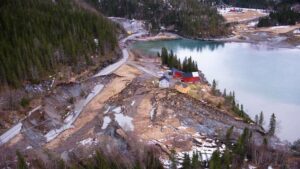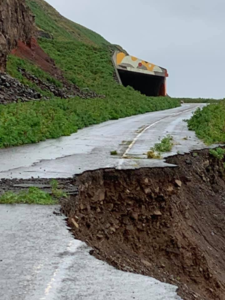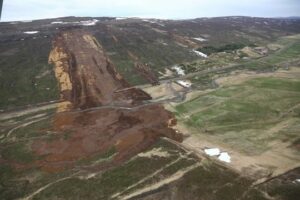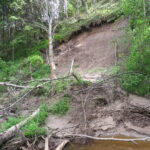How does landslides, coastal erosion and climate change affect us?
Landslides cause damage to buildings, buildings close to a slope or a hillside have the risk of getting buried in a landslide, coastal erosion causes land near the coastline to sink and climate change can cause more rainfall especially in Norway and this could lead to water getting stuck and water erosion happens.
Coastal erosion is a healthy and natural event for the ecosystem, but people have speed it up by their own actions. Coastal erosion happens with ocean streams, water streams and is the loss of land around the coast
Climate change affects us in many ways. In Norway, we do not notice so many changes. The small changes we notice is that the winter is shorter and warmer. It snows less and the spring is longer. The main reason for climate changes is increased amount of CO2 in the atmosphere.
Why does landslides, coastal erosion and climate change happen?
Landslides can be initiated in slopes already on the verge of movement by rainfall, snowmelt, changes in water level, stream erosion, changes in groundwater, earthquakes, volcanic activity, disturbance by human activities, or any combination of these factors.
Influence on the country (land and people)
Houses and buildings can be damaged.
People can die or get hurt.
The land can be destroyed.
Roads gets destroyed.
Are people more aware of more frequent landslides?
Yes, people around the areas with many landslides are more aware of more frequent landslides. They know what to do if they come in a situation where a landslide has happened or when there is a high risk of landslides.
How do they react to landslides?
Many people panic when a landslide happens. It is mostly because it’s something new and dangerous. People who have experienced landslides before will probably be calmer.
What can we do to prevent landslides?
We need to reduce CO2 to prevent landslides. Carbon dioxide is a fossil fuel that has a detrimental effect on the earth. To reduce carbon dioxide in the air we must plant some trees. Trees photosynthesize and give us oxygen.
Make everyone in the nearby area aware of the dangers of landslides. Make sure that the water’s flow does not get stuck because that will build up pressure and water erosion happen. Have insurance.
What can we do if a landslide happens?
Landslides can occur all year around. Sometimes ravines or mountain slopes can be very unstable and only need little rain or heat waves to trigger a landslide.
Why – how – influences on the country (both land and people) – are people aware of more frequent landslides – and how do they react?
Norway
- The country gets influenced by landslides because when a landslide happens, an area gets destroyed.
- Norway has a lot of valleys, mountains and because a lot of areas near slopes can get landslides.
- Norway does not get affected so often by landslides. Of course, there are some landslides that are bad and destroy a lot, but it is not so often.
- Since 2000 we have had 19 big landslides. It is almost 1 landslide each year. The average number of people who lost their life in each landslide is 1 person here in Norway.
- We have some zones where there is a high risk of landslides. These areas are on the west of Norway. The reason for that is because there are many mountain sides, and the landscape is different from the rest of Norway. There is also more rain on the west of Norway and rain is one of the factors for landslides.
- The biggest landslide in Norway happened in 1893. 116 people died and 105 farms got destroyed.
- Here is a video from the landslide that happened 2016 in the eastern part of Trollfjell Geopark.
Finland
- In Finland landslides do not affect people that badly as in some other countries.
- When landslides happen in Finland it is usually in a big esker.
- In Lapland landslides happen due to frost in the ground. It is usual in arctic areas, near Saana which is the highest fall in Finland.
- The last big landslide in Finland happened in 1924 which destroyed a long field and three barns.
- The pictures below are from Rokua Geopark in Finland.
- Landslide in a bank of River Poikajoki in western part of Rokua Geopark, Finland.
- Rivers and streams have carved deep and steep-sided ravines into the thick soils, and water erodes the slopes continuously. The steep slopes are vulnerable for landslides.
- Silt and clay have been washed from nearby esker and deposited on the bottom of early Baltic Sea (Litorian sea).
Iceland
- Landslides are common in Iceland.
- Landslides are known in all parts of the country, but the most common areas are in the Mid-North, the East fjords, and West fjords.
- Landslides are different in sizes and length and can occur at any time of the year. When the autumn is taking over Iceland from August to November, then there is the greatest risk of landslides.
- Landslides are happening more often in Iceland than it was before. It is connected to the climate change. “The reasons are for example more rain and more intense rain, increased coastal erosion, such as undercutting of coastal cliffs, due to higher ocean levels and larger and more frequent storms, and higher temperatures that can lead to the melt of permafrost, more frequent freeze-thaw cycles, and thermal expansion and retraction of rock. Climate change will also influence the vegetation in Iceland but should be positive as the vegetation cover should increase and extend higher up into the highlands.” https://geoheritage.fas.is/?page_id=198
- There are several places in Iceland that are very dangerous due to landslides.
- Landslides occur mainly in places where mountains are steep.
- There are several towns in Iceland that are under or surrounded by mountains.
- In winter when there is a lot of snow there is often an avalanche and it has destroyed towns and people have been hit by the avalanche.
- Landslides can also happen around glaciers because when glaciers are melting it can no longer support the cliffs.
- Most common landslides in Iceland are rock collapse.
- Earthquakes often occur on the Reykjanes peninsula. It can causes landslides.
- Some places that are mostly in danger are: Reynisfjara, Hvalfjörður, ÍSafjörður, Siglufjörður, Þvottárskriður, Ólafsvíkurenni and more.
- One of the most famous tourist destinations in Island is Reynisfjara which is a black beach with rocks on the other side. When people visit this place, they do not know about the danger that this place has. The danger is that the rocks can fall from the cliffs and the waves can be very strong and powerful.
- Micro-flood when it rains a lot in a short time and the flood come over and can e.g fill basements.
Written by Anna Karjalaine, Oskari Karppinen Vaalan lukio/Vaala Upper secondary school , Eydís Arna Sigurðardóttir, Harpa Sigríður Óskarsdóttir, Framhaldsskólinn í Austur-Skaftafellssýslu and Halvor Ellingsen, Malin Henrichsen, Brønnøysund videregående skole.






